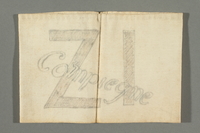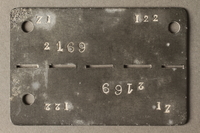Overview
- Description
- Documents, correspondence, photographs and newspaper clippings that belonged to John Waldman (donor's father) and his parents George and Betsy Waldman, who were interned as American citizens in Vittel internment camp in France.
- Credit Line
- United States Holocaust Memorial Museum Collection, Gift of Deborah Pearson and Janet Waldman
Physical Details
- Genre/Form
- Photographs. Newspaper articles. Letters.
- Extent
-
1 box
Rights & Restrictions
- Conditions on Access
- There are no known restrictions on access to this material.
- Conditions on Use
- Material(s) in this collection may be protected by copyright and/or related rights. You do not require further permission from the Museum to use this material. The user is solely responsible for making a determination as to if and how the material may be used.
Keywords & Subjects
- Corporate Name
- Vittel (Concentration camp)
Administrative Notes
- Holder of Originals
-
United States Holocaust Memorial Museum
- Legal Status
- Permanent Collection
- Provenance
- Donated to the United States Holocaust Memorial Museum in 2018 by Deborah Pearson, daughter of John Waldman, granddaughter of George and Betsy Waldman.
- Record last modified:
- 2024-03-08 07:34:44
- This page:
- https://collections.ushmm.org/search/catalog/irn619219
Download & Licensing
- In Copyright - Use Permitted
- Terms of Use
- This record is not digitized and cannot be downloaded online.
In-Person Research
- Request 7 Days in Advance of Visit
- Plan a Research Visit
-
Request in Shapell Center Reading Room
Bowie, MD
Contact Us
Also in Waldman family collection
The collection consists of artifacts, artwork, documents, correspondence, photographs, and newspaper clippings, relating to the experiences of John, George, and Betsy Waldman in Compiègne and Vittel internment camps and artists Jacques Gotko and David Goychman in Compiègne internment camp in France, during the Holocaust.
Date: approximately 1940-approximately 1945

Black and white linocut print of the Compiègne internment camp created by Jacques Gotko
Object
Linocut print of a yard in the Compiègne internment camp in German-occupied France created by artist Jacques Gotko in 1942. The print was acquired by George Waldman, who was held in Compiègne from December 1941 to July 1943. George, Betsy, and their teenage son, John, were American citizens who lived in Paris to manage their paper import-export business. In response to the German invasion of Poland, France declared war on Germany on September 3, 1939. In May of 1940, Germany invaded and quickly defeated France, occupying the northern half of the country. In 1941, the Germans began rounding up foreign born Jewish residents. Gotko, a native of the Soviet Union, was arrested in Paris in July 1941 and detained in Compiègne internment camp. In the camp Gotko painted watercolors, drew pencil sketches, and created linocuts of life in the camp and sent his earnings from portrait commissions to his wife. On December 12, 1941, a day after Germany declared war on the United States, George Waldman was arrested and detained at Compiègne as an enemy alien and later joined his wife and son in Vittel internment camp. In 1942, the Germans began to deport foreign born Jews to concentration camps in the east. In September, Gotko was transferred to Drancy internment and transit camp where he was reunited with his mother and sister. In November, his mother and sister were deported to Auschwitz-Birkenau concentration camp in German-occupied Poland. On July 18, 1943, Gotko was deported to Auschwitz, given prisoner number 130612, and was selected for forced labor. Gotko died of typhus on January 2, 1944, in Auschwitz.

Watercolor still life painting created by David Goychman while imprisoned in Compiègne internment camp
Object
Watercolor still life painting of fruit and a pitcher created by artist David Goychman while he was a prisoner in Compiègne internment camp in 1941. The painting was acquired by George Waldman, who was held in Compiègne from December 1941 to July 1943. George, Betsy, and their teenage son, John, were American citizens who lived in Paris to manage their paper import-export business. In response to the German invasion of Poland, France declared war on Germany on September 3, 1939. In May of 1940, Germany invaded and quickly defeated France, occupying the northern half of the country. In 1941, the Germans began rounding up foreign born Jewish residents. Goychman, a native of the Soviet Union, was arrested in Paris in June 1941 and detained in Compiègne internment camp. In the camp he continued to paint and took part in an art exhibition held in the camp. On December 12, 1941, a day after Germany declared war on the United States, George Waldman was arrested and detained at Compiègne as an enemy alien and later joined his wife and son in Vittel internment camp. In 1942, the Germans began to systematically deport foreign born Jews to concentration camps in the east. On September 11, 1942, Goychman was transferred to Drancy internment and transit camp. Three days later, he was deported to Auschwitz-Birkenau killing center in German-occupied Poland under the name Leizer Goychman. Goychman was killed at Auschwitz on September 19, 1942. This may be the only known surviving Goychman painting from his time in the camp.

Armband worn by a Jewish American prisoner in Compiègne internment camp
Object
Armband worn by George Waldman while he was held in Compiègne internment camp in France, from December 1941 to July 1943. George, Betsy, and their teenage son John were American citizens who lived in Paris to manage their paper import-export business. On September 3, 1939, in response to the German invasion of Poland, France declared war on Germany. In May of 1940, Germany invaded and quickly defeated France, occupying the northern half of the country. Despite their Jewish heritage, the Waldmans were left alone by the Germans due to their American citizenship. In response to the attack on Pearl Harbor, the United States declared war on Japan. Subsequently, Germany declared war on the U.S. on December 11, 1941. The next day George was arrested and detained at Compiègne as an enemy alien. On January 11, 1943, Betsy and John were arrested and detained in Vittel internment camp. In July, George was removed from Compiègne, taken to Vittel, and reunited with his family. Due to their American citizenship, the Waldmans received better treatment than other prisoners at the internment camps. They had hotel like accommodations, with heat and running water, were able to send and receive mail, and received weekly Red Cross packages. On September 12, 1944, the Vittel internment camp was liberated by Free French forces and the Waldmans returned to the United States in October 1945.

Prisoner ID tag issued to a Jewish American prisoner in Compiègne internment camp
Object
Prisoner ID tag issued to George Waldman, while he was held in Compiègne internment camp in France, from December 1941 to July 1943. George, Betsy, and their teenage son, John, were American citizens who lived in Paris to manage their paper import-export business. On September 3, 1939, in response to the German invasion of Poland, France declared war on Germany. In May of 1940, Germany invaded and quickly defeated France, occupying the northern half of the country. Despite their Jewish heritage, the Waldmans were left alone by the Germans due to their American citizenship. In response to the attack on Pearl Harbor, the United States declared war on Japan. Subsequently, Germany declared war on the U.S. on December 11, 1941.The next day George was arrested and detained at Compiègne as an enemy alien. On January 11, 1943, Betsy and John were arrested and detained in Vittel internment camp. In July, George was removed from Compiègne, taken to Vittel, and reunited with his family. Due to their American citizenship, the Waldmans received better treatment than other prisoners at the internment camps. They had hotel like accommodations, with heat and running water, were able to send and receive mail, and received weekly Red Cross packages. On September 12, 1944, the Vittel internment camp was liberated by Free French forces and the Waldmans returned to the United States in October 1945.



